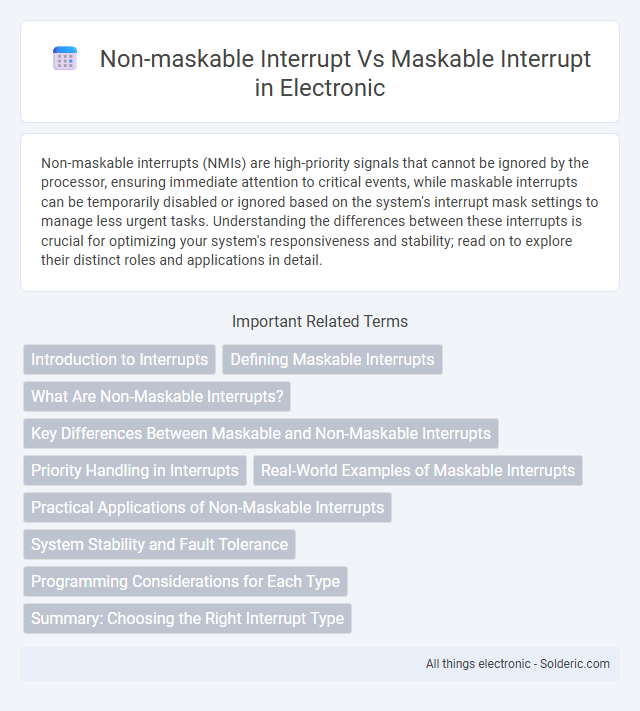Non-maskable interrupts (NMIs) are high-priority signals that cannot be ignored by the processor, ensuring immediate attention to critical events, while maskable interrupts can be temporarily disabled or ignored based on the system's interrupt mask settings to manage less urgent tasks. Understanding the differences between these interrupts is crucial for optimizing your system's responsiveness and stability; read on to explore their distinct roles and applications in detail.
Comparison Table
| Feature | Non-Maskable Interrupt (NMI) | Maskable Interrupt (MI) |
|---|---|---|
| Interrupt Masking | Cannot be disabled or ignored by the processor | Can be enabled or disabled by the processor or software |
| Priority | Higher priority, always serviced immediately | Lower priority, serviced only if enabled |
| Use Cases | Critical events like hardware failures, power issues | Regular hardware events, I/O device requests |
| Example Sources | Power failure, memory parity error | Keyboard input, timer interrupts |
| Interrupt Vector | Fixed vector address | Variable vector address |
| Handling Latency | Minimal latency, immediate attention | Depends on mask setting and priority |
Introduction to Interrupts
Non-maskable interrupts (NMIs) and maskable interrupts are critical components in computer systems for managing urgent and routine tasks, respectively. NMIs are high-priority hardware signals that cannot be ignored by the processor, ensuring immediate attention to critical system events such as hardware failures. Maskable interrupts, on the other hand, can be selectively enabled or disabled by the processor, allowing you to prioritize and control less critical tasks without disrupting essential operations.
Defining Maskable Interrupts
Maskable interrupts are hardware signals that can be ignored or delayed by the processor through software or system control settings, allowing your system to prioritize critical tasks effectively. These interrupts enable the CPU to mask or block less urgent signals while processing more important ones, enhancing multitasking and responsiveness. By managing maskable interrupts, you ensure that non-critical events do not disrupt essential operations, maintaining system stability and performance.
What Are Non-Maskable Interrupts?
Non-maskable interrupts (NMIs) are high-priority hardware interrupts that cannot be ignored or disabled by the processor, ensuring immediate attention to critical events like hardware failures or emergency signals. Unlike maskable interrupts, which the CPU can selectively mask or delay, NMIs guarantee prompt execution of the interrupt service routine to maintain system stability and prevent data loss. Typical applications of NMIs include watchdog timers, system crash notifications, and hardware error reporting in embedded systems and real-time computing.
Key Differences Between Maskable and Non-Maskable Interrupts
Maskable interrupts (MI) can be ignored or delayed by the CPU using interrupt enable or disable flags, allowing prioritization of processes. Non-maskable interrupts (NMI) are high-priority, cannot be disabled or masked, and trigger immediate attention for critical hardware failures or emergency events. The key difference lies in their handling: MI requests can be postponed, while NMI demands instant CPU response to ensure system stability.
Priority Handling in Interrupts
Non-maskable interrupts (NMIs) have the highest priority and cannot be ignored or delayed by the processor, ensuring immediate attention to critical events such as hardware failures. Maskable interrupts (IRQs) can be selectively enabled or disabled, allowing the processor to prioritize or defer less critical tasks based on the interrupt masking settings. Effective priority handling in interrupt-driven systems relies on NMIs for urgent issues while using maskable interrupts to manage routine device requests efficiently.
Real-World Examples of Maskable Interrupts
Maskable interrupts commonly occur in real-world scenarios such as keyboard inputs, where the CPU temporarily pauses current operations to process keystrokes. Network interface cards generate maskable interrupts to signal the arrival of data packets for immediate processing. Similarly, disk drives trigger maskable interrupts during read/write operations to coordinate data transfer without halting the entire system.
Practical Applications of Non-Maskable Interrupts
Non-maskable interrupts (NMIs) are critical in scenarios requiring immediate attention, such as hardware failure detection, system monitoring, and emergency shutdown procedures, where delays could cause data loss or hardware damage. Unlike maskable interrupts, NMIs cannot be ignored or disabled by the processor, ensuring that Your system responds promptly to high-priority events like power failures or memory errors. This guarantees robust fault tolerance and enhances system reliability in safety-critical applications.
System Stability and Fault Tolerance
Non-maskable interrupts (NMIs) enhance system stability by providing an immediate response to critical hardware failures, ensuring that severe faults are addressed without delay. Maskable interrupts allow for controlled handling of routine processes, enabling smoother multitasking and efficient resource management while maintaining overall fault tolerance. Your system benefits from the balance of NMIs for urgent error detection and maskable interrupts for regular task scheduling, optimizing stability and reliability.
Programming Considerations for Each Type
Non-maskable interrupts (NMIs) require programming strategies that prioritize immediate and critical response routines due to their inability to be ignored or disabled, often used for hardware failures or urgent events. Maskable interrupts allow configurable interrupt enable/disable mechanisms, enabling developers to design flexible and efficient interrupt handling by selectively masking less critical signals during specific code execution. Your code must carefully manage interrupt priority and context saving to ensure system stability and responsiveness across both types.
Summary: Choosing the Right Interrupt Type
Non-maskable interrupts (NMIs) provide critical, high-priority signals that cannot be ignored by the processor, making them ideal for urgent hardware failure or system error notifications. Maskable interrupts (IRQs) offer flexibility by allowing the processor to enable or disable them based on current tasks, suitable for routine hardware communication and multitasking. Selecting the appropriate interrupt type depends on the need for immediate attention versus controlled processing, ensuring system stability and efficient response.
non-maskable interrupt vs maskable interrupt Infographic

 solderic.com
solderic.com